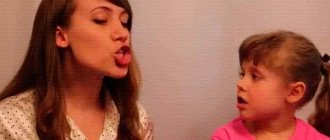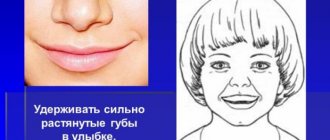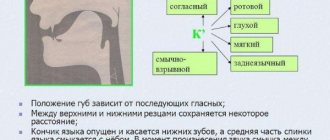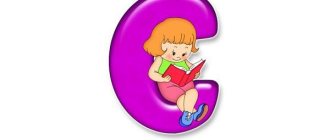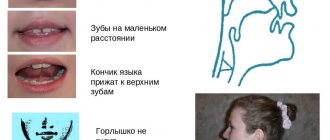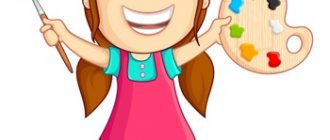Online speech therapy exercises
Speech therapy of vowels:
|
| | | | | | | | | Difficult vowels:
e;e;yu;ya |
e;u;e;y;a;o;e;ya;i;yu | Setting consonant sounds and letters:
|
| | | | | | | | | | | | | | | | | | | Difficult consonants:
b;p | w;w | z;s | g;k | s;ts | v;f | r;l | p;l | r;p;l | z;s;c | h;f;sh;sch;ts;x |
All speech therapy exercises on the website () are divided into classes. For example, you can find exercises for a specific letter. Teach your child poems, sayings, and reading books. Corrective work must be comprehensive and systematic. Online speech therapy exercises () can serve as a useful tool for speech therapists working with preschoolers. For certain reasons, the number of children with speech development disorders increases every year. A child's correct speech is good. On our website we have tried to provide you with everything you need to develop your baby’s speech. It is better to study often and in short portions than to arrange long lessons, but with long breaks. Online speech therapy classes allow children to develop communication skills.
Ways to make the sound “Ts”
There are several ways to set “C”. During the study process, the specialist selects speech therapy classes individually for each child.
- Production of “C” by imitation using game situations. Game “Don’t wake the baby”: put your finger to your mouth and say “Hush, hush, the baby is sleeping in her crib. Don’t wake him up, t-t-t-t-t!” Game “Feed the chicken!”: invite the child to repeat “Chicken, chicken, chicken, chicken!”
- The mechanical method is to use an auxiliary object. Often a teaspoon is used for these purposes. With its help, it is necessary to hold the tip of the tongue behind the teeth at the moment when the child tries to pronounce the sound “Ts”. In this case, the tongue should take the shape of a slide, its tip rests on the lower incisors, and the back touches the upper teeth and upper palate.
- Setting “C” from reference sounds. This method is used when a preschooler can pronounce the sounds “T” and “S”. The adult asks the child to use them quickly. Repeat this pronunciation several times.
Characteristics of a group of whistling sounds.
The group of whistling sounds includes the sounds S, S', Z, Z' and Ts (in transcription: [s], [s'], [z], [z'], [ts]). They are classified in the same group because they have similar articulation. For example, the sounds [s] and [z] differ only in the presence or absence of voice, the sounds [s] and [s'] differ in the additional rise of the middle part of the tongue.
[C]: consonant, oral, voiceless, fricative, anterior lingual, hard;
[Z]: consonant, oral, voiced, fricative, anterior lingual, hard;
[S'], [Z']: soft;
[C]: consonant, oral, voiceless, occlusive fricative, anterior lingual, hard.
In the group of whistling sounds, the basis is the articulation of the sound [s]. This sound is the basis for the entire group.
How to pronounce the sound [z] normally.
The sound [z] is a consonant, voiced, hard. Paired with it in softness is the sound [z'] (“z”), Paired in deafness is the sound [s].
When pronouncing the sound [z], the organs of articulation occupy the following position:
— lips
slightly stretched in a smile, so that the upper and lower incisors are exposed;
— teeth
brought closer together, forming a gap of 1-2 mm;
— Tip of the tongue
wide, located in the lower part of the lower front teeth;
— lateral edges of tongue
raised and tightly connected with the upper lateral teeth;
— dorsum of tongue
in its
anterior
part it forms a narrow gap with the upper alveoli for the exit of a stream of air;
— air jet
strong, runs down the middle of the tongue and feels cold when you bring the back of your hand to your mouth;
— soft sky
pressed tightly to the back wall of the throat, preventing air from escaping into the nose;
— vocal cords
closed and trembling, forming a voice.
Ways to stop sound [
z
]
No.
Method of setting
NO SOUND
The sound [z] is placed similarly to the sound [s], characterized by additional phonation of the vocal cords.
By imitation:
a) Discrimination by ear of the sounds [s-z] in words that are similar in sound composition, in syllables, among phonemes (see “Development of phonemic hearing”).
b) Tactile and vibration sensations from the work of the vocal cords. The child puts one hand (the back side) to the speech therapist’s neck, the other hand touches the child’s neck, “sss” - the voice is asleep, “zzz” - the voice is awake. "Mosquito" is ringing.
[h]
- a mosquito, a fly, a wasp rings
By imitation:
The child is offered a sample of sound pronunciation in combination with play images (a mosquito is ringing, a bell is ringing, etc.); At the same time, visual control of correct articulation and tactile (tactile) sensations are used.
From reference sound:
Perform exercises “Fence” - “Mosquito”. By imitation, say “iiiiii-zzzzzz.”
Note: when performing the sound [z], the child is not called, but is replaced with the name of the exercise “Mosquito”.
The sound [z] is easily differentiated from the sound [c], since these sounds have the same articulatory structure, that is, when pronouncing these sounds, the organs of articulation occupy the same position. The difference between the sounds is that [s] is voiceless, pronounced without a voice, and [z] is voiced, pronounced with a voice. Thus, to cause the sound [z], it is enough to add, “turn on” the voice when pronouncing the sound s.
The presence or absence of voice can be controlled by ear, as well as by tactile-vibration control. To do this, apply the back of the hand to the front surface of the neck in the larynx area. When you “turn on” your voice, your hand feels a slight vibration transmitted from the vocal folds. When you turn off the voice, the vibration disappears.
You can explain to children that when the little voice in the neck is “sleeping,” we don’t feel it, but when it wakes up, we can feel it jumping and having fun in its little house—the neck.
Having received the correct sound [z], you should practice pronouncing it for some time in isolation from other sounds: z-z-z. Children can be asked to ring like a mosquito or a bell.
With this sound, the position of the lips, teeth and tongue is the same as with the sound “C”. But this sound “3” is voiced: the folds are closed and vibrate, that is, it is pronounced with a voice. Ego needs to be explained to the child both by ear and by tactile sensation, that is, put the child’s hand on the larynx and pronounce the sounds “C” and “3” alternately. When the sound “3” is heard, the child will feel a vibration in the larynx. We learn to imitate a mosquito. The mosquito flew and rang protractedly - “33333.” For correct imitation you need to: expose all the teeth in a “smile”, the distance between the teeth is approximately 2 mm, the tip of the tongue rests on the upper part of the lower teeth, the exhaled stream goes exactly in the middle of the front incisors to the tip of the tongue, while the voice is involved. You can first start from “I” plus “S”, and then turn on the voice - “ISZZ”. First, the vowel “I” is taken, because with the sound “I” the tip of the tongue reflexively takes its original position, as with “C” or “3”, and at the same time a channel appears at the tip of the tongue through which an air stream moves to the front teeth. It is also possible from the combination “PIS”. The explosive sound “P” creates additional pressure and this helps the child feel the air stream more strongly. The child controls it with the back of his hand. In this combination, replace the sound “C” with “3”. Alternately portray and imitate either a “bird” or a “mosquito”. When the child learns to correctly pronounce the sound “3” in isolation, then you can begin to reinforce it.
From articulatory structure:
The child is asked to reproduce the articulatory pattern of sound, apply the correct air stream, and determine the presence/absence of a voice; the result should be a normalized sound.
Correct articulation
Scheme of articulation of the sound C and S.
When pronouncing “C” correctly, the tip of the tongue focuses on the lower incisors. Its body is arched, its back closes to the sky, and its edges are in tension. When the air flow leaves the mouth, there is an instantaneous opening of the tongue and palate. At this moment, the tip of the tongue moves slightly away from the lower teeth, thereby increasing the flow of escaping air.
The lips assume the position of a stretched smile. When pronouncing words containing straight syllables with the sound “C”, for example “sheep tso tso tso”, the teeth open.
Characteristics and articulation of the phoneme C
Explain to your child the structure of sound, qualitative characteristics (voiced or voiceless, paired or unpaired), as well as the nature of the formation of letters by the speech apparatus, so that it is easier for him to understand how a phoneme is formed. “C” is an unpaired dull sound. It has no counterpart in softness and is always hard. It is not softened by the vowel sound that comes after it (circus [tsyrk] or number [tsyfra]).
Important! You should tell your child about sound after he or she reaches a certain age ( grades 1-3 ).
Classes for preschoolers (5-6 years old) are best conducted in a playful way, without overloading the child with terms and concepts.
Articulation profile “C”:
Don't miss: What is dysgraphia?
Description of the articulation of the sound “C”:
- Tongue position:
- the tip focuses forward on the lower teeth;
- the organ is raised and arched like a mountain;
- the back closes with the sky;
- the sides become tense;
When the air stream comes out, quickly move the front part of the tongue away from the palate. We pull its tip slightly away from the lower incisors. This increases the push of air at the outlet.
2. Keep your lips smiling.
3. The incisors are closed or as close as possible (in isolated reproduction).
4. Vocal folds are relaxed. There is no vibration.
When playing the phoneme “C”, the air stream should be strong, explosive as you exhale. This characteristic is characteristic of the phoneme “T”. The letter “C” gives a whistling connotation. But the correct pronunciation of “S” and “T” does not mean that there are no problems with the sound “C”.
Articulation gymnastics
To make the sound “C”, it is necessary to pay special attention to special articulatory gymnastics. Exercises will be more effective if performed in front of a mirror. You need to start classes by warming up your tongue and lips.
You can invite your child to stretch his lips into a smile several times in a row and slap his lips with his tongue. It is better to start with easy exercises and gradually move on to more difficult ones.
Tongue exercises
- “Hamster”: rest your tongue on each cheek in turn and stay in this position for a while.
- “Pancakes”: stick out your tongue and place it on your upper lip in a relaxed state. Hold your tongue in this position for several seconds.
- “Painting the fence”: open your mouth, stretch your lips slightly. Use the tip of your tongue to move along the inside of the lower incisors up, down, and in different directions.
- “Slide”: arch your tongue upward. The tip of the tongue should rest against the lower teeth.
- “Eating jam”: with your mouth open, take out your tongue and lick your lower and upper lips in turn. The exercise should be performed by tensing the muscles of the tongue.
An exercise in which a child repeats words with the letter C after an adult.
For lips
- “Tube”: form your lips into a tube and hold them in a state of tension for a few seconds. Repeat the exercise 5-10 times.
- “Fence”: move your lips apart, exposing your teeth. The jaws are clenched. Stay in this position for 5 to 10 seconds.
To develop exhalation
- “Breeze”: place the tongue in a slide so that its tip rests against the lower teeth. Pass a stream of air along the tongue.
- “Pump”: insert the tip of the tongue between the teeth, while sharply opening them. The tongue must be forcefully returned to the teeth and at the same time a stream of air must be applied. When the exercise is performed correctly, a hard “T” sound is heard.
Staging and automation of sound [TS]
Staging and automation of sound [TS]
Consonant, stop - fricative, sibilant, affricate.
Articulation is normal when spoken in isolation.
The lips are open, take a position depending on the next sound, and tend to stretch into a smile like C. The teeth are compressed or brought together so that the distance between the incisors is 2 mm. The tip of the tongue rests on the lower incisors, the back at the first moment forms a bow with the upper incisors, then it closes with an explosion, in position C. A groove is formed on it, along which, after the explosion, a continuous air stream passes. The lateral edges are constantly pressed against the upper molars, the root is lowered. The position of the soft palate is raised, closing the passage into the nasal cavity. The position of the vocal cords is open. You can see the position of the lips, the distance between the incisors, if the mouth is slightly open - the position and work of the tongue. You can feel the absence of vibration in the chest and larynx, an air stream: first a sharp push of a cold stream of air, then a continuous stream of air.
Staging. On an auditory-visual basis from listening to the consonant in the syllable LETS, we compare FINGER - FOREST, LETS - FOREST, AC - AS (we use sound amplifying equipment). If it came from the AC (after 4 - 5 times repeating) - EC - LATS - FINGER. You can go from T + C = TS = C. Special exercises: the student is asked to blow through the lips close to each other + the closure of the lips and its explosion - PF (show on the hand brought to the mouth an air push and a subsequent smooth stream of exhaled air). Then return to the production of C, showing that the sound is similar to the labial sound just reproduced. AC - AC - CA CHICKEN - differentiation of C and C.
Types of incorrect pronunciation. Replacing C with S. Absence of the closing moment of a continuous sound, i.e. T. Show that the sound [C] begins with T + S, on a tactile - vibrational basis + vision. Replacing C with THOUS There is no close fusion of the stop and fricative moment due to the sharp jerking of the tongue and jaw during the explosion + incorrect position of the tongue, closing the front part with the gums of the upper teeth of the upper teeth. Please note that there is no voice, but with THOUS there is. “Sizzling sigmatism” C = Ch. It is necessary to show that the tip of the tongue should be at the lower incisors. “Lateral sigmatism” The back of the tongue is pressed against the upper incisors and does not perform push-like work. The side edges perform a jerk-like work. First you need to check the sound C (for lateral sigmatism). It needs to be corrected and the sound Ts must be re-installed.
Automation of sound [Ts] . We pronounce the sound [C] correctly in syllables. TsA, TsO, TsU, TsI, TsE, TsA-TsO, TsA-TsU, TsA-TsI, TsA-TsE, TsO-TsA, TsO-TsU, TsO-TsI, TsO-TsE, TsU-TsA, TsU-TsO, TSU-QI, TSU-TSE. We highlight the stressed syllables TsA TsA, TsA Tsatsa, , TsA TsA , TsA TsA TsA, Tsatsa TsA . We pronounce the sound C in the words HERON, CIRCUS, COMPASS, QUEEN, CHICKEN. We automate the sound [Ts] between the vowel sounds ATSA, OTSO, UTSU, YTSI, ATSO, UCA, OTSA, OTSU, ATSU. We pronounce the sound C in words. STREET, CLEVER, EXCELLENT STUDENT, STUDENT, STUDENT. Rocking chair, washcloth, sharpener, swing, head of cabbage. We correctly pronounce the sound Ts in combination with the consonant TsVO, TsVA, TsLO, TsMO, TsNO, TsRO, TsVA, TsLA, TsMA, TsNA, TsRA, TsVU, TsLU, TsMU, TsNU. We pronounce the sound C in words. SHEEP, FLOWER. We pronounce the sound Ts in the reverse syllable АЧ, ОЧ, УЧ УЧ. We pronounce the sound in words. END, LOLLIPOPY, FINGER, DAUGHTER, PINKY. We pronounce the sound [C] in sentences. USING A COMPASS TO DRAW A CIRCLE, THE CIRCUS HAS LEFT, A YELLOW CHICKEN.
Types of incorrect sound pronunciation
Children often try to replace the sound “C” with other consonants, the pronunciation of which is easier and does not require additional work of the tongue muscles. For example, replacing “C” with “S” (syplenok, rash, rash, rash), with “T” (chicken, typ, typ, typ), sometimes with “F” and “Ch” (fyplenok, phyp, phyp, fip, chiplenok, chip, chip, chip).
First, the adult asks the child to pronounce a control phrase (Chicken Little has a chain) to determine the correct pronunciation of the morpheme. Based on this, the speech therapist determines the method of sound production. If the child’s tongue tries to jump out of the mouth when pronouncing “C,” then we are talking about interdental sigmatism.
A teaspoon, with which you need to hold the tongue behind the lower teeth, will help correct this speech impediment.
When “C” in speech is replaced by sibilants, this is called sibilant sigmatism. In this case, we make the sound “C” by imitation using a mirror.
If “C” is replaced by the letter “F” during pronunciation, then the child has labiodental sigmatism. The index finger will help to cope with this problem, with the help of which you need to hold the lower lip while pronouncing the morpheme. As soon as the labial articulation returns to normal, the supports can be removed.
Speech therapy lesson summary - “Sound C”
Summary of correctional educational activities “The Adventures of Little Chicken” for children of senior preschool age
Goal: teaching children how to maintain health, stimulating performance, thinking and speech activity.
Correctional educational tasks: clarify the pronunciation of the sound [ts]; develop phonemic hearing, improve sound-syllable analysis of words. Correctional and developmental tasks: to develop intonation expressiveness of speech, thinking, auditory memory, visual perception, coherent speech, speech breathing.
Correctional and educational task: to form mutual understanding, goodwill, independence, initiative, responsibility.
Equipment: mirrors, individual diagrams, object pictures, finger puppets “chickens”, cane puppets: horse, chicken, fox, hare, bear, plot picture “In the yard”.
1. Organizational moment.
Speech therapist: - One, two, three, four, five - stand in a circle to play! A new day has come, let's greet it with a smile. I will smile at you, and you will smile at each other. We are calm and kind, we are friendly and affectionate. — Take a deep breath through your nose and inhale kindness, beauty, health, and exhale through your mouth all the resentments, anger, and sorrows (Lyrical music sounds.)
2. Report the topic of the lesson.
Speech therapist: Children, guess the riddle: “He appeared in a yellow fur coat, goodbye, two shells. Who is this?" (Chicken) Psycho-gymnastics: Picture a chicken sitting in an egg. Show how he gets out of the shell: first he sticks out his head, then the right wing, then the left. Chicken in the rain, chicken basking in the sun. Listen to the story that once happened to Little Chicken. The hen took her chicks out into the yard for a walk and to look for worms. And Little Chicken was the most naughty, at first he looked out from under the gate, saw a flowerbed with flowers (I show a large flower: color therapy - blue color) and decided to go smell the flowers, then he played tag with the grasshopper, then he studied the path of the caterpillar for a long time and... got lost. A chicken doll, Chick, appears: What should I do, how can I find my way home? (An audio recording of a horse's hooves tsk-tsk-tsk sounds) Chick: Oh, do you hear what that strange sound is? Speech therapist: Children, who do you think is jumping? (Horse) How do its hooves sound? (Ts-ts-ts) Today we will study the sound [ts] and help Chick return home.
3. Sound characteristics
Say the sound [ts] while observing the articulation in the mirror. Children analyze the pronunciation of the sound [ts] according to the diagram. The lips are in a smile, the teeth are close together but not closed, the wide tip of the tongue is lowered behind the lower teeth, the back of the tongue is pressed behind the upper teeth. A strong air stream breaks this barrier. The voice doesn't work. Speech therapist: -What sound [ts]? Children: (The sound [ts] is a consonant, always hard, deaf.)
4. Pronunciation exercise with elements of su-jok therapy, development of motor skills, prosodic components of speech.
Speech therapist: The Queen Horse will show us the way
a.) Pronunciation of the poem Pronunciation of the poem by tapping each syllable with the fingers of both hands, alternately from the thumb to the little finger (applicator casts). Clack-clack-clack! You are a horse, gray side. If you knock with your hoof, bring us home quickly.
b.) pronunciation of syllables jumps merrily over the pebbles: tsa-tso-tsa-tso neatly jumps over streams: ats-ots-uts climbs heavily up the mountain: tsva-tsvu-tsvy
Horse: Walk two squares to the right and one down from the well. There is a yats-za sitting under the tree, he will show you the way further. (One of the children makes a move on a sheet of paper lined in a box) Speech therapist: Children, who is this yat-za? (Hare).
5. Pronunciation of sounds in words, development of phonemic concepts.
Hare: I’ll show you the way if you help me name the words a). Game "Be careful". — Look at the picture “In the yard.” Name a word with the sound [ts], which has one syllable (two syllables, three syllables).
(Chain; eggs, porch, flowers, sheep, starling; stairs, hen, chickens, greenhouse, cucumbers, well.)
Hare: Go two cells down and three to the left, there is someone waiting for you near the old mill (Children guess the word fox by the first sounds)
6. Development of auditory attention and memory, sound-syllable analysis and synthesis of the word “chicken”.
Fox: Oh, what wonderful children. Do you want to play with me? The “Remember-Repeat” game with elements of self-massage. Open, third eye. Teach us quickly. We massage the point on the bridge of the nose. Our memory will become better. Check it out yourself. Massage the points on the temples. Suggested words are heron, ring, scissors, flowers Starling, singer, lollipop, well done Fox: Tell me, what is the name of the chicken's mother? Children: Chicken. Sound analysis of the word chicken
Speech therapist: -How many syllables are in the word chicken? (Three) -Name the first syllable. (Ku) - How many sounds are there in it, name them. (K, y) The syllables “ri” and “tsa” are parsed similarly. Children independently lay out the diagram of the word. Fox: Well done, you did everything right. Go four cells down and one to the right, there is someone sitting in the clearing, eating candy.
Speech therapist: Guess who is sitting in the clearing. In the name of this animal, the first sound is [m], the last is [a], its cubs are small bear cubs. Bear: You guessed correctly, well done. Smell the way my flowers smell.
7. Formation of a long speech exhalation, relaxation.
Exercise “Oh, how candy smells!”
Now rest in my clearing, and then I will show you the way further. Muscle relaxation “Magic Mat”
Together with the speech therapist, the children take hold of the edges of the mat. Everyone lifts it up together, inhaling, and as you exhale, lower the rug down and say in a drawn-out manner: “Oooh.” The exercise is repeated 3 times. Then the rug is spread out, the children stand around it and say the “magic” words: “One, two, three - rest!” Then the children walk onto the mat, make a circle (sun) and lie with their heads in the center of the circle (calm music sounds)
The eyelashes droop... The eyes close... We rest calmly... (2 times) We fall asleep in a magical sleep... Our hands rest... They get heavy, they fall asleep... (2 times) The neck is not tense, But it is relaxed... The lips slightly open... So pleasantly relaxed. (2 times) Breathe easily, evenly, deeply. We are having a wonderful holiday. We fall asleep in a magical sleep... It’s good for us to rest, But it’s time to get up.
8. Prevention of visual fatigue and myopia.
Speech therapist: Look at what a beautiful butterfly flies over the clearing.
Let's follow the flight of the butterfly with our eyes. (Butterfly simulator) Children follow with their eyes along a given trajectory.
Bear: Well, guys, did you have a rest? Listen, where should you go next: go three cells to the right and one up, there on the outskirts of the village there is a house in which a chicken lives. (One of the children makes a move)
Speech therapist: And here is the house where the chicken Tsyp lives. (The picture “Chickens in the yard” is displayed) The chickens saw Little Chicken, were delighted and invited him to play with him and invent tall tales.
9. Development of coherent speech.
Children come up with a fabled dream about what happened to the chicken and the object that is drawn in the picture.
10. Reflection.
Speech therapist: Today we did a good deed, we helped the chicken find its way home. And who helped us and showed us the way? (Children's answers).
Municipal budgetary preschool educational institution "Kindergarten No. 8 of a combined type, Novooskolsky district, Belgorod region." Prepared by teacher-speech therapist MBDOU d/s No. 8: Shchekina Tatyana Alekseevna
Also on topic:
Production of the sound C, articulation of the sound C
General recommendations
As a rule, by the age of 3-4 years, children begin to use whistling sounds in their speech. If this does not happen, you need to seek the help of a specialist or try to correct this problem yourself through articulatory gymnastics and speech therapy exercises.
The problem of a child’s speech defect should not be left to chance, since incorrect pronunciation of sounds will also be reflected in the spelling (dysgraphia).
Classes should be selected taking into account the age and individual characteristics of the child. Experts recommend practicing every day for 5-10 minutes, then the result will not be long in coming, and the child will not be overtired.
